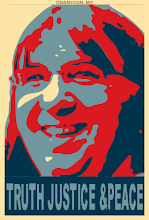Hidden in Plain Sight
"And the poverty problem -- listen, this nation is committed to dealing with poverty."
-- George W. Bush, Washington, DC, 19 May 2003
Not surprisingly, the facts are in stark contrast, as portrayed in this article in The Observer (UK), 37 million poor hidden in the land of plenty. As the tag-line states:
"Americans have always believed that hard work will bring rewards, but vast numbers now cannot meet their bills even with two or three jobs. More than one in 10 citizens live below the poverty line, and the gap between the haves and have-nots is widening."
The article notes:
The Observer also provides some relevant statistics at the end of the article:The flickering television in Candy Lumpkins's trailer blared out The Bold and the Beautiful. It was a fantasy daytime soap vision of American life with little relevance to the reality of this impoverished corner of Kentucky.
The Lumpkins live at the definition of the back of beyond, in a hollow at the top of a valley at the end of a long and muddy dirt road. It is strewn with litter. Packs of stray dogs prowl around, barking at strangers. There is no telephone and since their pump broke two weeks ago Candy has collected water from nearby springs. Oblivious to it all, her five-year-old daughter Amy runs barefoot on a wooden porch frozen by a midwinter chill.
It is a vision of deep and abiding poverty. Yet the Lumpkins are not alone in their plight. They are just the negative side of the American equation. America does have vast, wealthy suburbs, huge shopping malls and a busy middle class, but it also has vast numbers of poor, struggling to make it in a low-wage economy with minimal government help.
A shocking 37 million Americans live in poverty. That is 12.7 per cent of the population - the highest percentage in the developed world. They are found from the hills of Kentucky to Detroit's streets, from the Deep South of Louisiana to the heartland of Oklahoma. Each year since 2001 their number has grown.
Under President George W Bush an extra 5.4 million have slipped below the poverty line. Yet they are not a story of the unemployed or the destitute. Most have jobs. Many have two. Amos Lumpkins has work and his children go to school. But the economy, stripped of worker benefits like healthcare, is having trouble providing good wages.
Even families with two working parents are often one slice of bad luck - a medical bill or factory closure - away from disaster. The minimum wage of $5.15 (£2.95) an hour has not risen since 1997 and, adjusted for inflation, is at its lowest since 1956. The gap between the haves and the have-nots looms wider than ever. Faced with rising poverty rates, Bush's trillion-dollar federal budget recently raised massive amounts of defence spending for the war in Iraq and slashed billions from welfare programmes.
For a brief moment last year in New Orleans, Hurricane Katrina brought America's poor into the spotlight. Poverty seemed on the government's agenda. That spotlight has now been turned off. 'I had hoped Katrina would have changed things more. It hasn't,' says Cynthia Duncan, a sociology professor at the University of New Hampshire.
An America divided
· There are 37 million Americans living below the poverty line. That figure has increased by five million since President George W. Bush came to power.
· The United States has 269 billionaires, the highest number in the world.
· Almost a quarter of all black Americans live below the poverty line; 22 per cent of Hispanics fall below it. But for whites the figure is just 8.6 per cent.
· There are 46 million Americans without health insurance.
· There are 82,000 homeless people in Los Angeles alone.
· In 2004 the poorest community in America was Pine Ridge Indian reservation. Unemployment is over 80 per cent, 69 per cent of people live in poverty and male life expectancy is 57 years. In the Western hemisphere only Haiti has a lower number.
· The richest town in America is Rancho Santa Fe in California. Average incomes are more than $100,000 a year; the average house price is $1.7m.
(Via Philadelphia Freedom Watch)

No comments:
Post a Comment